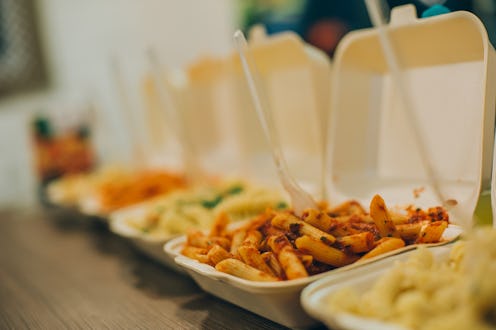Life
Never Put These 11 Things In The Microwave
Having a microwave can be extremely convenient when it comes to reheating last night's pizza or when you're in rush and need to quickly whip up a baked potato. But the kitchen gadget isn't made for everything, and there are certain items you should never, ever put into the microwave — unless you're looking to start a fire in your kitchen.
"While microwaving food is convenient and quick, it unfortunately [can come] with dangerous consequences," says certified health coach Isadora Baum over email. "It's also important to take note of the packaging of your food, as certain materials can contain a host of chemicals, such as benzene and zylene, among other carcinogens, that can increase risk of cancer. Packaging that contains BPA is incredibly dangerous, as BPA can result in hormone instability, infertility, and heart and brain disease, among others."
However, when it comes to the nutrients of your food, you don't need to worry much. Although some people believe that microwaving your food kills its nutrients, using a microwave is no different than any other heating method. In fact, since microwaves use less heat and shorter cooking times, they may even be more effective at preserving nutrients than other forms of heating, according to the New York Times. The main items you need to worry about are things that can catch on fire or make a nasty mess in your kitchen.
Next time you want to heat something up, consider these 11 items that should never go inside the microwave.
1. Plastic Containers
"Heating foods in plastic containers is a big no-no and is very dangerous," says Dr. Phoenyx Austin, MD over email. "When you heat plastics — most specifically the ones that contain a man-made compound called BPA — you can end up creating nasty carcinogens (aka cancer-causing compounds), which can then leach directly into your foods."
2. Plastic Wraps
Like plastic containers, any sort of plastic wrap should be kept away from the microwave as well. If you do get a packaged food that says to reheat, make sure the label says "microwave-safe," but try not to let the plastic wrap touch the food in case it should melt.
3. Styrofoam
Although some styrofoam is specifically labeled "microwave safe," styrofoam is another type of packaging that contain chemicals that can leach onto your food. If there's no safe label, transfer your food out of the styrofoam before reheating.
4. Breast Milk
"A study in the journal Pediatrics found that breast milk heated in the microwave showed a decrease in healthy enzyme activity and an 18 times higher growth of e-coli than breast milk not heated in the microwave," says Austin. The FDA also advises against warming breast milk in the microwave, as it can heat unevenly, resulting in "hot spots" that can burn the baby's mouth.
5. Foil
"Metal objects, including aluminum foil, are known for emitting sparks and catching fire," says Dr. Scott Schreiber over email. Foil absorbs heat extremely quickly in a microwave, and this can cause sparks that can hit something else in the oven and begin a fire.
6. Meat
Although it's okay to reheat your meat, sticking uncooked meat in the microwave can pose a problem because the meat doesn't always cook evenly, leaving some pieces potentially raw or undercooked. "Microwave use can cause bacteria to spread within meat products and can be hazardous to your health," says Baum.
7. Chinese Takeout Containers
Takeout boxes from Chinese restaurants often contain metal, which like foil, can spark a fire in your microwave. Transfer into a microwave safe bowl before reheating your orange chicken.
8. Brown Bags
Paper bags are another type of material that don't belong in the microwave. The USDA advises against cooking in brown paper bags, stating that: "They are not sanitary, may cause a fire, and may emit toxic fumes."
9. Fruit
It probably doesn't sound too appealing to put fruit in the microwave in the first place, but if for some reason you need to heat it up, the microwave probably isn't the place to do it. "Fruit cannot stand up to these temperatures and may overheat," says Baum.
10. Hot Peppers
"Capsaicin in hot peppers can become too hot under microwave temperatures and can burn your throat," says Baum. The chemicals released when you open the microwave door can also sting your eyes, according to Huffington Post.
11. Eggs
Some articles online suggest making quick hard-boiled eggs in the microwave, but experts advise against this — unless you want to deal with some explosive yolks. "Hard-boiled eggs are too tricky to make in a microwave," says Baum. "You'll only find yourself with a mess."
When in doubt, always check packaging to look for labels that say microwave-safe, or if you're unsure, opt for another type of container or heating method instead.
Want more women's health coverage? Check out Bustle's new podcast, Honestly Though, which tackles all the questions you're afraid to ask.
Images: guruXOX/Fotolia, Linda Bestwick/Fotolia, abimagestudio/Fotolia, Bluesky60 /Fotolia, Panithan/Fotolia, romeof/Fotolia, Sławomir Fajer/Fotolia, Sergey/Fotolia, wissanustock/Fotolia, baibaz/Fotolia, jesus/Fotolia, istetiana/Fotolia
